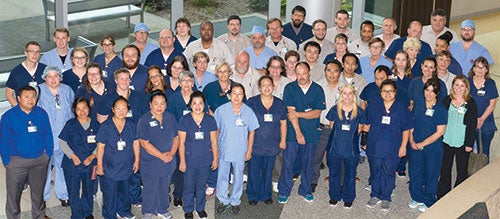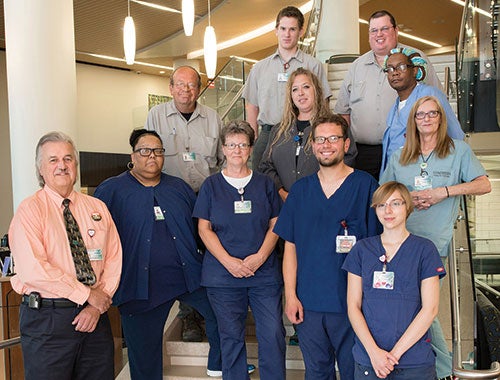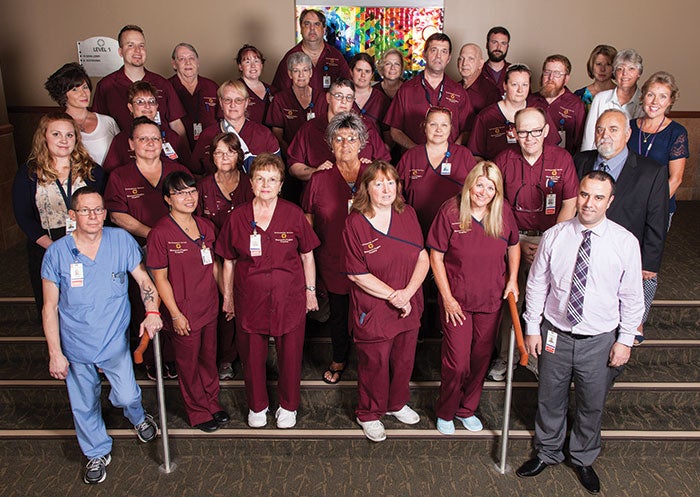2016 Environmental Services Department of the Year: Gundersen Health System

Members of Gundersen Health System's environmental services team

Winners
200–500 BEDS CATEGORY
Gundersen Health System
La Crosse, Wis.
Brian Stuempges, Environmental services manager
Up to 199 BEDS CATEGORY
Wentworth-Douglass Hospital
Dover, N.H.
Michael Catanzaro, FAHE, MREH, CLLM, CHESP, Director of environmental services
Honorable Mention
200–500 BEDS CATEGORY
Harborview Medical Center
Seattle
Jeff Dale, Director of housekeeping
Legacy Salmon Creek Medical Center
Vancouver, Wash.
Travis Diffenbaugh , Manager of environmental services and linen
Nemours Children’s Health System
Orlando, Fla.
Joe McLaughlin, Resident district manager
Up to 199 BEDS CATEGORY
Blanchard Valley Hospital
Findlay, Ohio
Robin Cranmer, Manager of environmental services, linen, communications and hazardous materials
Montrose (Colo.) Memorial Hospital
Denise Rivera, Director of environmental services
Jonathan Theodore, Supervisor
Judges
Dr. J. Hudson Garrett Jr. , PhD, MSN, MPH, FNP, CSRN, PLNC, VA-BC, global chief clinical officer, Pentax Medical
Marci A. Butts, CHESP, director of ancillary and support services, The Jewish Hospital–Mercy Health
Laura Faye, Sustainability Roadmap coordinator, Blue Environmental Performance Consulting
Sponsors
Association for the Healthcare Environment
SCA
Gundersen Health System, a La Crosse, Wis.-based network of six medical centers and dozens of clinics in Wisconsin, Minnesota and Iowa, has long been recognized for championing environmental sustainability. Among its achievements in this realm, Gundersen Health became the first health system in the country to produce more energy than it consumed in late 2014.
Overseeing hospital cleaning and maintenance for the 325-licensed-bed enterprise, Gundersen Health’s environmental services (ES) department exemplifies the organization’s systemwide commitment to optimizing efficiency, reducing waste and surpassing previous successes, with the ultimate goal of making health care more affordable and effective. Its motto, “Every patient is my patient. Never put your wants or needs ahead of the patient,” underpins every task and initiative the ES department undertakes.
This patient-centered approach “is something we live and breathe at Gundersen Health System and instill in our staff,” notes ES Manager Brian Stuempges. Accordingly, the ES department continuously researches ways to improve its processes, always prioritizing patient health, safety and satisfaction, he says.
To measure patient satisfaction, Gundersen Health uses the HCAHPS survey, benchmarking its performance against Hospital Compare data for more than 4,000 Medicare-certified hospitals. On the two questions most pertinent to environmental services, the health system earned high ratings in 2015.
When asked how often their room and bathroom were kept clean, 80 percent of Gundersen Health’s surveyed patients responded “Always,” exceeding the national average of 74 percent. Asked to rate their hospital more generally on a scale of zero to 10, 84 percent of patients gave Gundersen a nine or 10 — eight percentage points higher than the national average of 76 percent.
“We make sure patients’ needs and wants are taken care of,” says Mike Becker, an ES supervisor. It’s not uncommon for ES employees to help patients with wayfinding or locating the appropriate member of their care team to deal with a specific issue. At weekly meetings, ES management recognizes staff for service excellence, sharing patient stories and feedback.
While focusing on patients, Gundersen Lutheran Medical Center's (La Crosse, Wis.) ES team in 2015 realized many quantifiable accomplishments in the domains of productivity enhancement, infection control, and worker injury reduction, leading judges to name Gundersen Health the Environmental Services Department of the Year in the larger health system category. Sponsored by the Association for the Healthcare Environment and SCA, the award recognizes superb ES performance in 16 critical areas. Health Facilities Management is the media partner for the award program.

Gundersen Health System environmental services department first shift
Establishing consistent procedures
The ES department made significant gains in productivity last year by standardizing more of its procedures. The effort helped Gundersen Health increase the amount of space cleaned by each full-time equivalent employee by 505 square feet a day. “When you have clarity for staff, you avoid confusion and inefficiency,” says Stuempges.
In prior years, cleaning the rooms vacated by discharged patients took too much time, sometimes forcing newly admitted patients to wait, because ES teams frequently had to first remove medical equipment such as infusion pumps from the rooms. Nursing staff, in turn, would have trouble finding this equipment later.
By partnering with nursing unit managers, Gundersen Health’s ES department established a clear division of labor and consistent procedures, which improved efficiency and allowed for more thorough room cleaning and disinfection. Beginning last year, nursing staff became responsible for removing patient care items from discharge rooms. That way, ES workers could begin cleaning as soon as they entered the room.
Although this may seem like a simple solution, it was not easy to implement because old habits are difficult to break, notes Kim Luehmann, the ES supervisor at Gundersen Health who championed the new protocol. To clarify who does what, the ES department created a laminated checklist that spells out the different responsibilities of ES vs. nursing and emphatically instructs ES staff to call the charge nurse if any items are left in the room.
“When we started using this approach, the issue of finding items in patient rooms at discharge was eliminated in a matter of days,” Stuempges says.
To further streamline the process of cleaning discharge rooms, Gundersen instituted strategic scheduling last year. After reviewing data, the ES department identified that peak patient-discharge times occurred between 1 and 4 p.m. As a result, the department moved its second shift start time from 2:30 p.m. to 1:30 p.m. and its first shift start time from 6:30 a.m. to 7:30 a.m. “We now have a 2 1/2-hour overlap of shifts during this very busy period of the day,” Stuempges points out.
To maximize productivity in the clinical setting, the ES department requires staff to do team cleaning, with each team member assigned a section of the floor. If employees finish their work early, they assist their co-workers and only move to the next floor when all of the work has been finished.
“With team cleaning, we are more efficient, and members of the team are accountable to each other,” Stuempges says.
Seemingly small procedural changes have yielded big results. For example, the department installed a KeyWatcher system to keep track of ES workers’ keys. Employees swipe their badges to draw the keys they need for the day from an electronic key cabinet. If a key is not returned at the end of shift, the supervisor receives an electronic notification and contacts the employee.
Before the implementation of KeyWatcher, employees had to wait in line to pick up their keys from security staff, causing inefficiencies for both the ES and security departments. What’s more, keys often were misplaced, handed from one employee to another without documentation.
“The new system has helped us tremendously,” says Kyle Koske, an ES supervisor. “Since we implemented it, we haven’t lost any keys because staff members are more accountable.”

Gundersen Health System environmental services department second shift
Minimizing microorganisms
Working more efficiently means having additional time to thoroughly disinfect patient rooms. In 2015, Gundersen Health invested in four portable ultraviolet light (UV) disinfection devices (one per floor) for use at the end of the discharge room-cleaning process. “We still do the manual scrubbing, but the UV light provides a second layer of disinfection,” Luehmann says.
To evaluate the effectiveness of its cleaning and disinfection processes, Gundersen Health’s ES department performs monthly adenosine triphosphate (ATP) swab testing of high-touch surfaces in patient rooms, such as the bed rail, the door knob and the toilet flusher. Although the department has been doing ATP testing for the past five years, the numbers improved dramatically in 2015, according to Stuempges.
“When we first did ATP testing, we were getting numbers in the thousands,” he observes. “Working with infection control, we got the number down to 300 [relative light units] after a couple of years. So we made a stretch goal of 150 [relative light units].” In 2015, the ES department not only reached and maintained that target, but also trimmed the number to double digits in many surgical areas.
Reducing staff injuries
The ES department’s employee safety numbers also improved substantially last year. Compared with 2014 figures, reported injuries dropped from 86 to 74 and recordable injuries from 29 to 18. The department saw a huge reduction in lost days, from 97 to 18, and in restricted days, from 640 to 130.
The department holds monthly safety meetings at which guest speakers address different topics, which Stuempges says has been key to these improvements. “We alternate days of the week each month, so the meetings don’t always fall on a regular day off for any members of our staff,” says Stuempges. In addition, supervisors hold daily staff huddles that reinforce safety tips.
One major change last year was the replacement of upright vacuum cleaners with backpack units. “Some of our staff preferred the upright vacuums, so we had some resistance with this change,” Stuempges says. “But when using upright vacuums, staff are more susceptible to injuries.”
When pushing an upright vacuum, a worker’s shoulders are bent and there is more repetitive motion,
Stuempges explains. “The lightweight backpack vacuums are a lot more ergonomic,” he says.
The overall emphasis on safety not only has improved the lives of Gundersen Health’s ES employees, but also resulted in significant financial savings — more than an eightfold reduction in the department’s direct injury-related costs.

Gundersen Health System environmental services department third shift
Collaborative commitment
Gundersen Health’s ES department played an important role in the system's receiving Practice Greenhealth's Less Waste Circle award in 2015. Envision, which is Gundersen’s environmental sustainability program, helped the health system to reduce its solid waste generation by almost 50 percent and attain a recycling rate of 45 percent, among other conservation measures.
The ES department also helped to implement a single-bin pharmaceutical collection program, designed to prevent pharmaceutical waste from being flushed down the drain, and assisted with the collection of unused medical supplies, which were donated to health care charities. In addition, the department collected and repackaged leftover hydrogen peroxide disinfectant, donating containers of the cleaning product to a local humane society. Such initiatives are just a sampling of those involving Gundersen Health’s ES department last year.
The most important factor in driving up such a broad spectrum of metrics is a dedicated staff, emphasizes Stuempges. ES workers take part in process improvement decision-making and have opportunities to earn extra pay and recognition. For example, employees receive a payment differential for working the second or third shift, and the third shift receives additional paid time off. In addition, staff members earn extra bonus pay for working more than a set number of weekends and premium pay for any holidays they work.
During the annual National Healthcare Environmental Services Week (the third week of September), Gundersen Health’s ES employees receive a small gift and daily food treats.
Especially motivating, according to Koske, is Gundersen Health’s “High Five” peer-to-peer recognition program, in which individuals who’ve gone the extra mile are singled out for praise by their co-workers during monthly staff meetings.
“We try to do as much as possible to keep staff engaged,” Koske says. “We let them know that the work they do is very important and much appreciated.”
Carolyn Schierhorn is a freelance writer based in Wheaton, Ill., who specializes in health care and construction.




